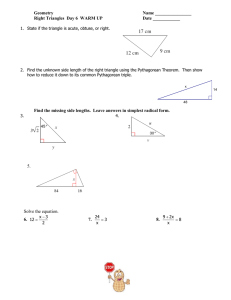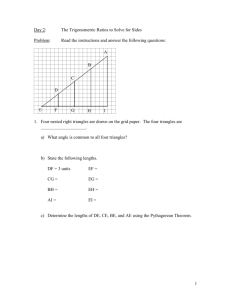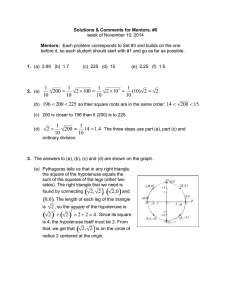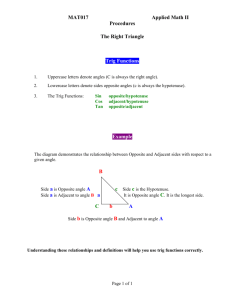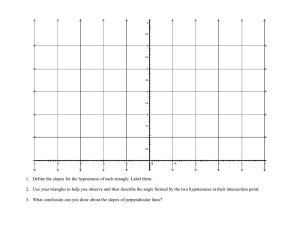Right Triangle Trigonometry
advertisement
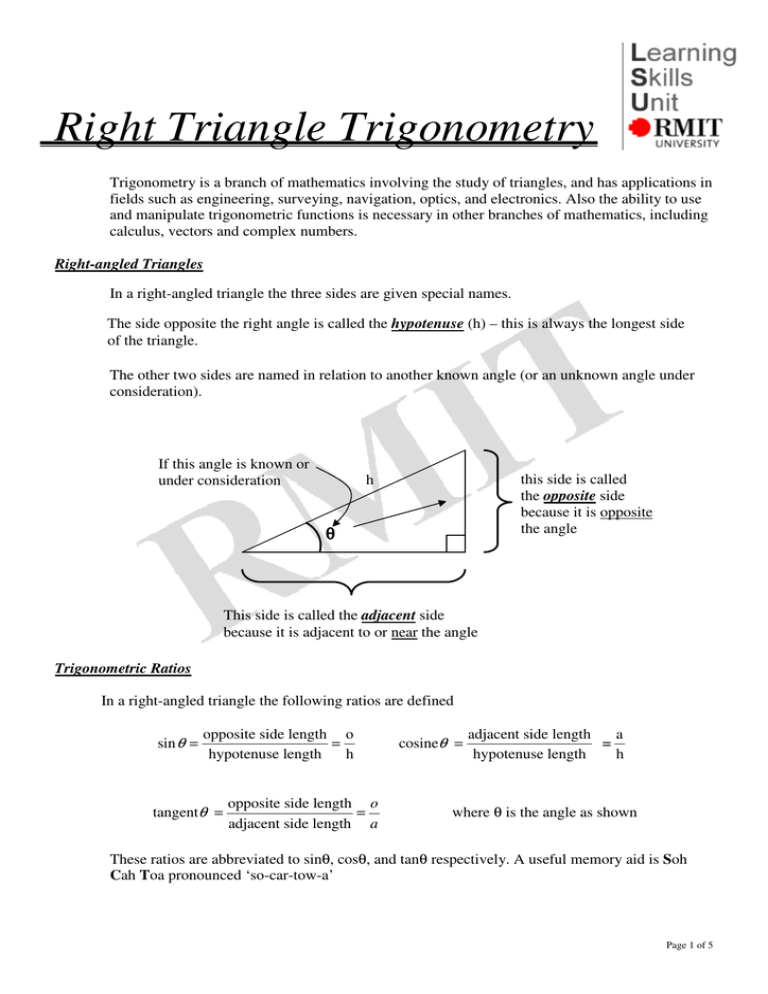
Right Triangle Trigonometry Trigonometry is a branch of mathematics involving the study of triangles, and has applications in fields such as engineering, surveying, navigation, optics, and electronics. Also the ability to use and manipulate trigonometric functions is necessary in other branches of mathematics, including calculus, vectors and complex numbers. Right-angled Triangles In a right-angled triangle the three sides are given special names. The side opposite the right angle is called the hypotenuse (h) – this is always the longest side of the triangle. The other two sides are named in relation to another known angle (or an unknown angle under consideration). If this angle is known or under consideration this side is called the opposite side because it is opposite the angle h θ This side is called the adjacent side because it is adjacent to or near the angle Trigonometric Ratios In a right-angled triangle the following ratios are defined sin θ = opposite side length o = hypotenuse length h tangentθ = opposite side length o = adjacent side length a cosineθ = adjacent side length a = hypotenuse length h where θ is the angle as shown These ratios are abbreviated to sinθ, cosθ, and tanθ respectively. A useful memory aid is Soh Cah Toa pronounced ‘so-car-tow-a’ Page 1 of 5 Unknown sides and angles in right angled triangles can be found using these ratios. Examples Find the value of the indicated unknown (side length or angle) in each of the following diagrams. (1) b Method 1. Determine which ratio to use. 2. Write the relevant equation. 3. Substitute values from given information. 4. Solve the equation for the unknown. 27o 42 In this problem we have an angle, the opposite side and the adjacent side. The ratio that relates these two sides is the tangent ratio. tan θ = opposite side adjacent side Substitute in the equation: (opposite side = b, adjacent side = 42, and θ = 27o) b 42 b = 42 × tan 27° b = 21.4 tan 27° = transpose to give (2) In this triangle we know two sides and need to find the angle θ. θ 13.4 cm 19.7 cm The known sides are the opposite side and the hypotenuse. The ratio that relates the opposite side and the hypotenuse is the sine ratio. opposite side hypotenuse 13.4 sin θ = 19.7 sin θ = 0.6082 sin θ = opposite side = 13.4cm. hypotenuse = 19.7cm. This means we need the angle whose sine is 0.6082, or sin −1 0.6082 from the calculator. ∴ θ = 42.90 Page 2 of 5 Pythagoras’ Thoerem Pythagoras’ Theorem states that in a right angled triangle the square of the length of the hypotenuse side (h), is equal to the sum of the squares of the other two sides. h 2 = a 2 + b 2 h b a Pythagoras’ Theorem can be used to find a side length of a right angled triangle given the other two side lengths Example 1 find the value of h 2 2 h =6 +8 2 ∴ h 2 = 36 + 64 ∴ h 2 = 100 h 6 cm Pythagoras’ Theorem for this triangle square root of 100 ∴ h = 10 8 cm Note Measurements must be in the same units and the unknown length will be in these same units so h will be 10 cm find the value of x Example 2 4.2 2 = 2.7 2 + x 2 x 2.7 ∴17.64 = 7.29 + x 2 ∴10.35 = x 2 ∴ x = 3.22 4.2 Page 3 of 5 Exercise Find the value of the indicated unknown (side length or angle) in each of the following diagrams. (a) (b) 35o 4.71 mm a 62o 14 cm a (c) (d) 4.8 cm θ z 6.2 cm 6.5 20.2 α (e) (f) 500 a b 34 27o 42 Page 4 of 5 Special angles and exact values There are some special angles that enable us to obtain exact solutions for the functions and tan. sin, cos If we take the two triangles below, and apply the basic trigonometry rules for sine, cosine and tangent – sine = opposite hypotenuse cosine = adjacent hypotenuse tangent = opposite adjacent 45o 60o 2 2 1 1 30o 45o 3 1 From these two triangles, exact answers for sine, cosine and tangent of the angles 30o, 45o and 60o can be found. 1 1 , cos 45 o = , tan 45 o = 1 2 2 3 1 sin 60o = , cos 60o = , tan 60o = 3 2 2 1 3 1 sin 30 o = , cos 30 o = , tan 30 o = 2 2 3 sin 45 o = Answers Exercise (a) 2.7mm (b) 6.6cm (c) z=7.8cm, α=37.70 (d) 18.80 (e) 44.4 (f) 47.1 Page 5 of 5
